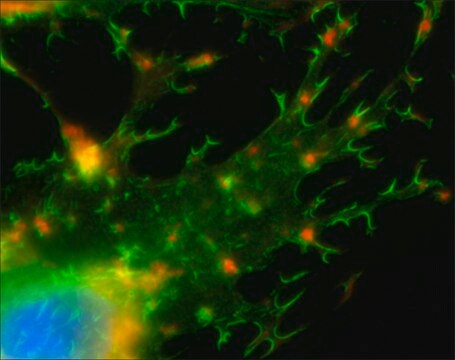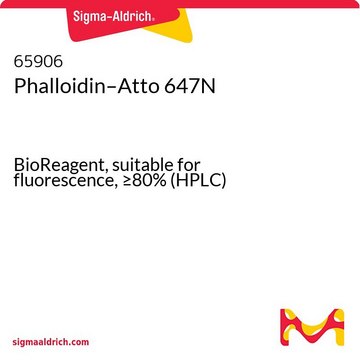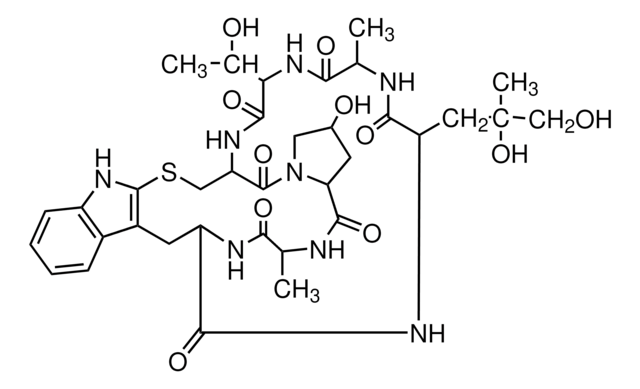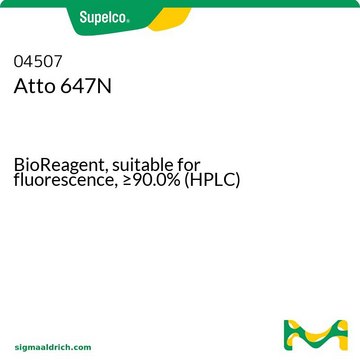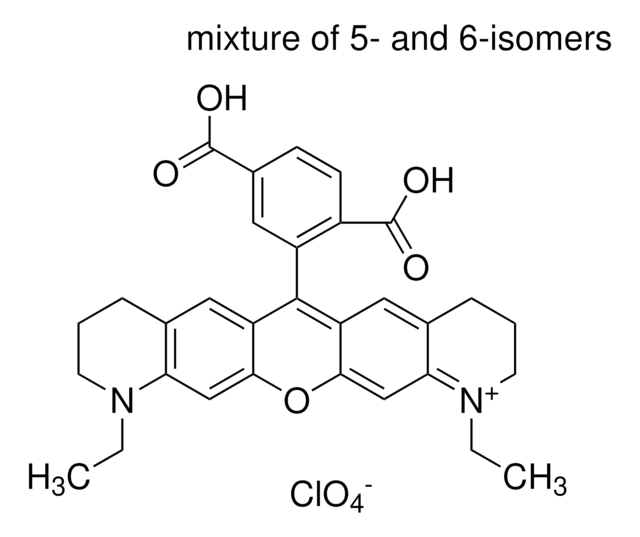94072
Phalloidin–Atto 565
suitable for fluorescence, ≥80.0% (HPLC)
Sign Into View Organizational & Contract Pricing
All Photos(1)
About This Item
UNSPSC Code:
12352108
NACRES:
NA.32
Recommended Products
Quality Level
Assay
≥80.0% (HPLC)
form
solid
mol wt
Mw 1394 g/mol
manufacturer/tradename
ATTO-TEC GmbH
λ
in methanol
UV absorption
λ: 562.0-568.0 nm Amax
suitability
suitable for fluorescence
storage temp.
−20°C
General description
Atto 565 is a novel fluorescent label that belongs to the class of Rhodamine dyes. It shows a strong absorption, high fluorescence quantum yield, high thermal and photostability, and a very little triplet formation. Atto 565 consists of a mixture of two isomers with practically identical optical absorption and emission Phalloidin is a fungal toxin isolated from the poisonous mushroom Amanita phalloides. Its toxicity is attributed to the ability to bind F actin in liver and muscle cells. As a result of binding phalloidin, actin filaments become strongly stabilized. Phalloidin has been found to bind only to polymeric and oligomeric forms of actin, and not to monomeric actin. The dissociation constant of the actin-phalloidin complex has been determined to be on the order of 3 x 10-8. Phalloidin differs from amanitin in rapidity of action; at high dose levels, death of mice or rats occurs within 1 or 2 hours. Fluorescent conjugates of phalloidin are used to label actin filaments for histological applications. Some structural features of phalloidin are required for the binding to actin. However, the side chain of amino acid 7 (g-d-dihydroxyleucine) is accessible for chemical modifications without appreciable loss of affinity for actin.
find more information here
find more information here
Storage Class Code
11 - Combustible Solids
WGK
WGK 3
Flash Point(F)
Not applicable
Flash Point(C)
Not applicable
Choose from one of the most recent versions:
Already Own This Product?
Find documentation for the products that you have recently purchased in the Document Library.
Customers Also Viewed
Recombinant Extracellular Matrix Protein Fragments Support Human Embryonic Stem Cell Chondrogenesis.
Aixin Cheng et al.
Tissue engineering. Part A, 24(11-12), 968-978 (2017-12-28)
We previously developed a 14-day culture protocol under potentially GMP, chemically defined conditions, to generate chondroprogenitors from human embryonic stem cells (hESCs). In vivo work has confirmed the cartilage repair capacity of these cells in a nude rat osteochondral defect
Silke Rothenbusch-Fender et al.
Biology open, 6(12), 1876-1888 (2017-11-11)
During
A Béduer et al.
Acta biomaterialia, 76, 71-79 (2018-06-09)
We present a 3D-printing technology allowing free-form fabrication of centimetre-scale injectable structures for minimally invasive delivery. They result from the combination of 3D printing onto a cryogenic substrate and optimisation of carboxymethylcellulose-based cryogel inks. The resulting highly porous and elastic
PALM and STORM. Unlocking live-cell super-resolution.
Henriques, R.; Griffiths, C.; Hesper Rego, E.; Mhlanga, Musa M.
Biopolymers, 95(5), 322-331 (2011)
Direct stochastic optical reconstruction microscopy with standard fluorescent probes.
van de Linde, S.; et al.
Nature Protocols, 6(7), 991-1009 (2011)
Our team of scientists has experience in all areas of research including Life Science, Material Science, Chemical Synthesis, Chromatography, Analytical and many others.
Contact Technical Service